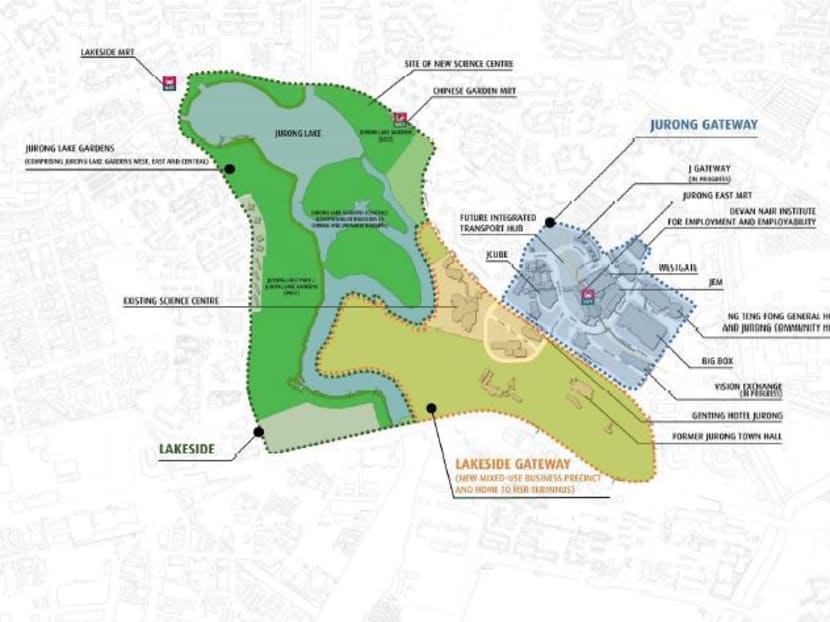Jurong Lake District to be second CBD, call for plans issued
SINGAPORE — The Government is seeking proposals for transforming the Jurong Lake District into the Republic’s second Central Business District, which will be anchored by the upcoming Kuala Lumpur-Singapore High-Speed Rail (HSR) terminus.
SINGAPORE — The Government is seeking proposals for transforming the Jurong Lake District into the Republic’s second Central Business District, which will be anchored by the upcoming Kuala Lumpur-Singapore High-Speed Rail (HSR) terminus.
Launching a Request for Proposal on Monday (July 11), the Urban Redevelopment Authority (URA) and the district’s steering committee — led by National Development Minister Lawrence Wong — have spelt out six goals that teams should be guided by in the masterplanning exercise.
First, the core area around the HSR terminus should offer “flexible and adaptable work spaces” to facilitate a mix of businesses and services, such as research and development, education, training and business incubators.
The district is also envisioned as a “24/7 hub” that offers retail, entertainment and leisure options outside working hours, as well as residences and common recreational facilities.
It will be a car-lite district, with a public transport mode share projected to be higher than the national target of 75 per cent by 2030. The district’s natural and heritage assets — such as the Jurong Lake and Jurong River, the former Jurong Town Hall building — should also shape a “distinctive identity”.
Highlights like the upcoming Jurong Lake Gardens, future recreational facilities, and the current and new Science Centres, will also anchor the district as a leisure destination for locals and foreign visitors.
Finally, innovative urban infrastructure — such as underground solutions — will be used to cater to the needs of different developments in the district in a productive and efficient manner, and sustainable strategies to mitigate the urban heat island effect and improve energy efficiency should be used.
Located between the district’s Jurong Gateway and Lakeside precincts, the 112-ha Lakeside Gateway is currently home to extensive greenery, water bodies, and the Jurong Country Club — which was acquired last year to make way for developments.
The upcoming Jurong Region Line and Cross-Island Line, together with the current North-South and East-West MRT lines, is also expected to improve traffic in the region.
Interested teams are to submit information on their team composition, track record, and a statement detailing their planning and design approach, and strategies to overcome anticipated challenges, by Sept 5.
Up to five teams will be shortlisted to develop their concept master plans for the district over ten weeks. The best team will be appointed in February next year, and thereafter work with URA and its partner agencies to draw up a Draft Master Plan for the district.
Members of the public will be able to give feedback on the plan around the third quarter of next year.
Implementation of the plan will be “studied carefully”, said the URA in a media release on Monday.
“(It will take) into consideration various factors including the broader plans of surrounding areas, development of other projects in the district, and the needs of the community,” it said.
Property analysts whom TODAY spoke to were generally positive about the potential impact of the development plans.
But Century 21 chief executive Ku Swee Yong noted there are competing developments in other parts of the island, such as plans to develop a Northern Gateway in the Woodlands area.
The success of Jurong Lake District would depend on whether it is “the precinct of top priority for developing Singapore to face challenges of the future economy”, he added.
The HSR would also be pivotal to bringing in significant economic benefits to the Jurong Lake District. “There needs to be demand first in the area, before new developments can come up,” he said.
Mr Colin Tan, director of research and consultancy at Suntec Real Estate Consultants, said the HSR, along with the push to make the Jurong Lake District a “24/7 hub” would increase movement to the area “throughout all hours of the day, even late at night”.
This could help the area stand out, he said, cautioning against “just replicating another Raffles Place”.
He also felt the Jurong area now stood a better chance of successfully become a second business centre. Compared to Tampines — another regional centre that was earmarked for development as a business hub — Jurong has critical mass with a mixture of residential, retail and hotel developments.
Suggesting ways in which the developments could shape up, Ms Christine Li, director of research at Cushman & Wakefield, said: “Office buildings could also go towards more campus-like environment with the aid of smart mobility devices.”
There could also be another business hotel with a convention centre, targeting transit travelers using the HSR. “Jurong Lake District could try to incorporate a range of landed and low rise condominiums with smart elements and waterfront views as their selling points, giving rise to perhaps a more affordable “Sentosa Cove in the suburbs”,” added Ms Li.










